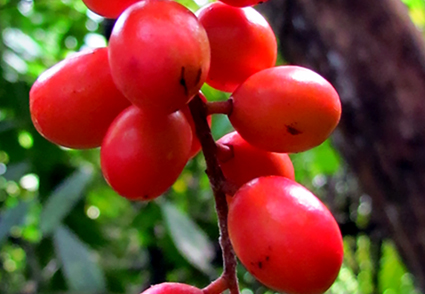Abstract
Three new species of Picramniaceae from Colombia are described and illustrated; Aenigmanu chococola from the Pacific region is the second species of the previously monotypic genus, known only from the Amazon region. In addition to its allopatric distribution, the new species is mainly recognisable by its wide leaf blades, which are basally convex and commonly apically emarginate at the very tip, and long bracts on the pistillate inflorescences. Nothotalisia karsticola and Picramnia vinacea are from karst areas in the Magdalena Valley; the former is mainly recognisable by its long inflorescences, pistillate inflorescences in racemes, staminate flowers with long petals and anthers apically mucronate, whereas the latter is mainly recognisable by its racemose inflorescences in both staminate and pistillate plants, pedicel length in staminate flowers, filaments shorter than the petals and glabrous fruits. We also include notes about their taxonomic affinities, habitat, geographical distribution, phenology, etymology and conservation status. A key for species of Nothotalisia is provided.
References
- Angiosperm Phylogeny Group (2016) An update of the Angiosperm Phylogeny Group classification for the orders and families of flowering plants: APG IV. Botanical Journal of the Linnean Society 181: 1–20. https://doi.org/10.1111/boj.12385
- Bentham, G. (1839–1857) Plantas Hartwegianas imprimis Mexicanas. Societate Linnaeana Londinensi, London, 393 pp.
- Beentje, H. (2016) The Kew plant glossary: an illustrated dictionary of plant identification terms, ed. 2. Royal Botanic Gardens, Kew, 184 pp.
- Bernal, R. (2016) Geografía de Colombia. In: Bernal, R., Gradstein, S.R. & Celis, M. (Eds.) Catálogo de plantas y líquenes de Colombia. Instituto de Ciencias Naturales, Universidad Nacional de Colombia, Bogotá, pp. 19–32.
- Celis, M. (2016) Picramniaceae. In: Bernal, R., Gradstein, S.R. & Celis, M. (Eds.) Catálogo de plantas y líquenes de Colombia. Instituto de Ciencias Naturales, Universidad Nacional de Colombia, Bogotá, pp. 2062–2063.
- Dauby, G. (2019) ConR: Computation of parameters used in preliminary assessment conservation status. R package version 1.2.4. Available from: https://CRAN.R-project.org/package=ConR (accessed 10 July 2020)
- Ellis, B., Daly, D.C., Hickey, L.J., Johnson, K.R., Mitchell, J.D., Wilf, P. & Wing, S.L. (2009) Manual of leaf architecture, 1st ed. Cornell University Press, Ithaca, 190 pp. https://doi.org/10.1079/9781845935849.0000
- Engler, H.G.A. (1874) Simarubaceae. In: Martius, C.F.P. & Eichler A.G. (Eds.) Flora Brasiliensis 12 (2). Fleischer, Leipzig, pp. 197–284.
- Fernando, E.S. & Quinn, C.J. (1995) Picramniaceae, a new family, and a recircumscription of Simaroubaceae. Taxon 44: 177–181. https://doi.org/10.2307/1222440
- Gentry, A. (1986) Species richness and floristic composition of Choco region plant communities. Caldasia 15 (71/75): 71–92. https://www.jstor.org/stable/43406071
- Hewson, H.J. (2019) Plant indumentum: a handbook of terminology, revised edition. Australian Biological Resources Study, Commonwealth Department of the Environment and Energy, Canberra, 47 pp.
- IUCN. (2012) IUCN Red List categories and criteria, version 3.1, second edition. IUCN Species Survival Commission. Gland, Switzerland and Cambridge, England, 32 pp.
- Kottek, M., Grieser, J., Beck, C., Rudolf, B. & Rubel, F. (2006) World map of the Köppen Geiger climate classification updated. Meteorologische Zeitschrif 15: 259–263. https://doi.org/10.1127/0941-2948/2006/0130
- Kubitzki, K. (2007) Picramniaceae. In: Kubitzki, K. (Ed.) The families and genera of vascular plants, IX, flowering plants: eudicots: Berberidopsidales, Buxales, Crossosomatales, Fabales p.p., Geraniales, Gunnerales, Myrtales p.p., Proteales, Saxifragales, Vitales, Zygophyllales, Clusiaceae Alliance, Passifloraceae Alliance, Dilleniaceae, Huaceae, Picramniaceae, Sabiaceae. Springer, Heidelberg, pp. 301–303. https://doi.org/10.1007/978-3-540-32219-1_39
- Liebmann, F.M. (1853) Novorum plantarum mexicanarum generum decas. Videnskabelige Meddelelser fra Dansk Naturhistorisk Forening i Kjøbenhavn 1853: 90–107.
- Macbride, J.F. (1934) New or renamed spermatophytes mostly Peruvian. Candollea 5: 346–402.
- Moreno, G.R. & Ledezma-Rentería, E. (2007) Efectos de las actividades socio-económicas (minería y explotación maderera) sobre los bosques del departamento del Chocó. Revista institucional universidad tecnológica del Chocó 26: 58–65.
- Planchon, J.E. (1846) Revue de la famille des Simaroubées. London Journal of Botany 5: 560–584.
- Pirani, J.R. (1990) As espécies de Picramnia Sw. (Simaroubaceae) do Brasil: uma sinopse. Boletim de Botânica 12: 115–180. https://doi.org/10.11606/issn.2316-9052.v12i0p115-180
- Pirani, J.R. (2005) Picramniaceae. In: Berry, P.E., Yatskievych, K. & Holst, B.K. (Eds.) Flora of the Venezuelan Guayana 9: Rutaceae–Zygophyllaceae. Missouri Botanical Garden Press, St. Louis, pp. 177–179.
- Rangel-Ch., J.O. (2004) Amenazas a la biota y a los ecosistemas del Chocó biogeográfico. In: Rangel-Ch., J.O. (Ed.) Colombia diversidad biótica IV. El Chocó biogeográfico/Costa Pacífica. Instituto de Ciencias Naturales. Bogotá, pp. 841–866.
- Sanchez-Cuervo, A.M. & Aide, T.M. (2013) Identifying hotspots of deforestation and reforestation in Colombia (2001–2010): implications for protected areas. Ecosphere 4: 1–21. https://doi.org/10.1890/ES13-00207.1
- Shipunov, A., Carr, S., Furniss, S., Pay, K. & Pirani, J.R. (2020) First phylogeny of bitterbush family, Picramniaceae (Picramniales). Plants 9: 284. https://doi.org/10.3390/plants9020284
- Standley, P.C. (1936) Studies of American plants VI. Publications of the Field Museum of Natural History, Botanical Series 11: 145−276. https://doi.org/10.5962/bhl.title.2345
- Swartz, O.P. (1788) Nova genera et species plantarum. Swederi, Stockholm, 152 pp.
- Swartz, O.P. (1797) Flora indiae occidentalis 1. Palmii, Erlangen, 640 pp.
- Thiers, B. (2016 onward) Index herbariorum: a global directory of public herbaria and associated staff. New York Botanical Garden’s Virtual Herbarium. The New York Botanical Garden, Bronx. Available from: http://sweetgum.nybg.org/science/ih/ (accessed 2 March 2022)
- Thomas, W.W. (1988) A conspectus of Mexican and Central American Picramnia (Simaroubaceae). Brittonia 40: 89–105. https://doi.org/10.2307/2806882
- Thomas, W.W. (1990) A new species of Picramnia (Simaroubaceae) from Amazonian Peru. Brittonia 42: 171–174. https://doi.org/10.2307/2807207
- Thomas, W.W. (2011) Nothotalisia, a new genus of Picramniaceae from tropical America. Brittonia 63: 51–61. https://doi.org/10.1007/s12228-010-9130-8
- Thomas, W.W., Hensold, N., Foster, R., Ree, R.H. & Soares Neto, R.L. (2021) Aenigmanu, a new genus of Picramniaceae from western Amazonia. Taxon 70: 1239–1247. https://doi.org/10.1002/tax.12588
- Tulasne, L.R. (1847) Flore de la Colombie. Plantes nouvelles. Annales des Sciences Naturelles, Botanique série 3 7: 257–296.


